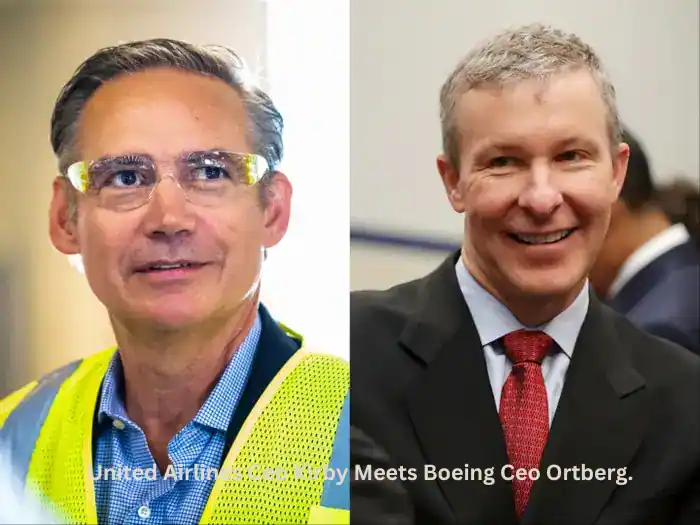
Introduction to the meeting between United Airlines CEO Scott Kirby and Boeing CEO Dennis Muilenburg Ortberg
In a notable gathering that has the aviation world buzzing, United Airlines Ceo Kirby Meets Boeing Ceo Ortberg. This meeting marks an important moment for both companies as they navigate through the complexities of the airline industry. With challenges like supply chain disruptions and evolving customer expectations, their discussions could shape policies and innovations in air travel. What does this encounter mean for passengers and stakeholders alike? Let’s dive into what unfolded during this pivotal meeting between two giants in the skies.
Background on United Airlines and Boeing
United Airlines, a major player in the aviation industry, has been serving travelers since 1926. With an extensive network and a fleet of over 800 aircraft, it connects millions of passengers to destinations worldwide. The airline prides itself on its commitment to customer service and innovation.
On the other hand, Boeing is a titan in aerospace manufacturing. Established in 1916, it designs and produces commercial jets that set standards for safety and efficiency. Boeing’s aircraft are known for their advanced technology and performance capabilities.
These two giants share more than just an industry; they have forged partnerships that shape air travel as we know it today. Their collaboration influences everything from aircraft design to operational strategies. As leaders in their fields, both United Airlines and Boeing play pivotal roles in defining the future of aviation.
The Purpose of the Meeting
The meeting between CEO Kirby and Boeing’s Ortberg was driven by a combination of strategic interests. Both leaders aimed to enhance collaboration for mutual growth.
A significant focus was on addressing the current supply chain challenges. United Airlines has faced delays that impact operational efficiency. Coordinating with Boeing is vital in ensuring timely delivery of aircraft.
Another key agenda item involved discussing innovation in aviation technology. Embracing sustainable practices is important for both companies as they navigate an evolving industry landscape. Exploring new fuel sources and eco-friendly designs could set them apart from competitors.
Additionally, the dialogue centered around improving customer experience. Enhancing cabin features and onboard services can elevate passenger satisfaction. A united approach may lead to groundbreaking developments in airline travel.
These discussions reflect a commitment to shaping a resilient future for both organizations within a competitive market.
Discussion Points and Key Takeaways
During their meeting, CEO Kirby and Boeing CEO Ortberg tackled various pressing issues facing the aviation industry. One significant topic was the ongoing supply chain challenges that have affected aircraft deliveries.
They also discussed safety protocols, emphasizing how both companies can collaborate to enhance passenger confidence. The recent technological advancements in aviation were highlighted too, showcasing opportunities for innovation.
Sustainability took center stage as well. They explored initiatives aimed at reducing carbon emissions and transitioning to more eco-friendly operations. Both leaders recognized the urgency of addressing climate change while ensuring profitability.
Additionally, they shared insights on customer experience enhancements, focusing on seamless travel solutions that cater to passengers’ evolving needs. This discussion may lead to new strategies that elevate service standards across the board.
The exchange underscored a mutual commitment to overcoming obstacles together in an ever-evolving landscape.
Impact on the Airline Industry
The meeting between CEO Kirby and Boeing CEO Ortberg holds significant implications for the airline industry. Their discussions centered around innovation, sustainability, and customer satisfaction—crucial pillars that define modern air travel.
As airlines like United push for greener solutions, Boeing’s role in developing fuel-efficient aircraft becomes even more vital. This partnership could accelerate advancements in eco-friendly technology across fleets.
Moreover, the collaboration aims to enhance passenger experiences through improved service offerings. By aligning strategies, both leaders signal a commitment to addressing evolving traveler expectations.
In an era marked by fierce competition, this alliance may set new benchmarks within the sector. Other airlines will likely observe closely as United Airlines embarks on initiatives shaped by these high-level talks.
Investor sentiment is also affected; positive outcomes from such meetings can influence stock performance and market confidence in both companies moving forward.
Public Response and Future Plans
The meeting between CEO Kirby and Boeing’s Ortberg has sparked varied reactions from the public. Many industry insiders see it as a sign of renewed collaboration between two giants in aviation.
Social media buzzed with opinions ranging from excitement to skepticism. Some supporters expressed optimism about potential advancements in aircraft technology and safety measures, while others raised concerns over past issues that plagued both companies.
Future plans appear ambitious yet cautious. United Airlines aims to modernize its fleet significantly, potentially adding more fuel-efficient models sourced from Boeing. Meanwhile, Boeing is under pressure to restore faith in its production processes.
As these leaders collaborate on future strategies, stakeholders will be watching closely for updates on innovations promising enhanced travel experiences and environmental sustainability initiatives within the airline sector.
Conclusion: What’s Next for United Airlines and Boeing?
Both United Airlines and Boeing are at pivotal points in their respective journeys. The meeting between United Airlines Ceo Kirby Meets Boeing Ceo Ortberg. marks not just a collaboration of two industry giants, but also a strategic alignment that could reshape the future of air travel.
As they navigate challenges such as sustainability and evolving consumer demands, their partnership will be crucial. Innovations discussed during the meeting may lead to advancements in fuel efficiency, customer experience, and safety measures—key areas where both companies aim to excel.
The world watches closely as these leaders chart new paths forward. With public response indicating strong interest in sustainable practices, it’s clear that what happens next will significantly impact not only United Airlines and Boeing but the broader airline industry too.
Stakeholders remain hopeful for tangible outcomes. Both firms have set ambitious goals that may change how we think about air travel altogether. As developments unfold from this significant meeting between United Airlines Ceo Kirby Meets Boeing Ceo Ortberg., travelers can anticipate improvements on multiple fronts in the skies ahead.





